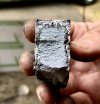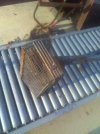CWLONGSHOT
Well-Known Member
I was smelting yesterday. But last three times I forgot a bucket of junk mostly sheet lead but some pipe and stick on ww. When all was done... I STILL FORGOT the bucket of stick ons!! GRRR
Anyhow. In that bucket was a plate someone made. It was very flat, 4.5" wide and 1" thick and nearly 16" long. One end was jagged as if cracked off. This shoulda spoken to me but I didnt look twice.
I to the pot it went. After a good thirty minutes the sheet lead was molten the piles too. Some big chunks mostly melted but this plate was standing tall.... It was pretty heavily oxodised and looked like the rest of that soft lead. It was not!! I pulled it and set it aside. As I started next pot I had time and figured I would bend that plate and get more of its surface into the pot. On a angle my buddy whacked it with a 5# hammer and second strike it cracked but did not bend at all!!!! I side was very crystalline!!!

A dozen more sharp strikes and it was into chunks small enough for my 10# LEE specialty pot. I cast one bullet to test and have read. Two hours outta the pot it was a BHN11. FAR FAR from soft/pure lead!!!
As comparison the range scrap read a 6BHN two hours out. (I know it will harden up)
I know its impossible to know Contents based upon a picture. But can anyone speculate?
CW
Anyhow. In that bucket was a plate someone made. It was very flat, 4.5" wide and 1" thick and nearly 16" long. One end was jagged as if cracked off. This shoulda spoken to me but I didnt look twice.
I to the pot it went. After a good thirty minutes the sheet lead was molten the piles too. Some big chunks mostly melted but this plate was standing tall.... It was pretty heavily oxodised and looked like the rest of that soft lead. It was not!! I pulled it and set it aside. As I started next pot I had time and figured I would bend that plate and get more of its surface into the pot. On a angle my buddy whacked it with a 5# hammer and second strike it cracked but did not bend at all!!!! I side was very crystalline!!!

A dozen more sharp strikes and it was into chunks small enough for my 10# LEE specialty pot. I cast one bullet to test and have read. Two hours outta the pot it was a BHN11. FAR FAR from soft/pure lead!!!
As comparison the range scrap read a 6BHN two hours out. (I know it will harden up)
I know its impossible to know Contents based upon a picture. But can anyone speculate?
CW

